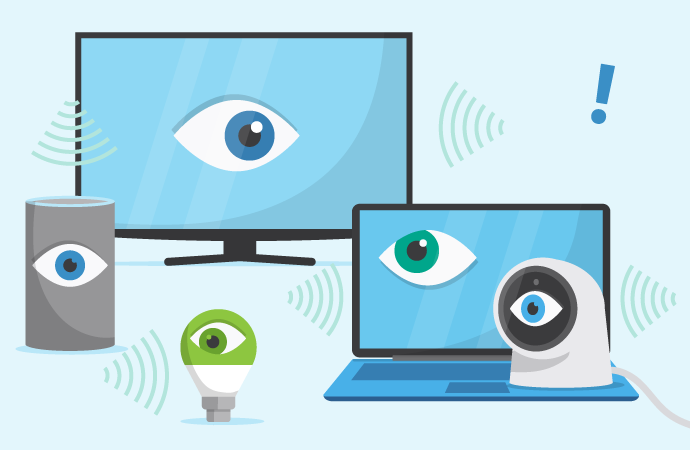In an era where connectivity reigns supreme, the Internet of Things (IoT) has revolutionized the way we interact with technology. While the convenience and automation offered by IoT devices are undeniable, they also introduce new risks and vulnerabilities.
But hold off on trashing your Alexas and automatic curtain-openers. Instead, let’s explore how to secure IoT devices, mitigate potential risks, and safeguard your spaces against threats. Remember, IoT isn’t bad – but as with any tool you use, you should do the right thing to make sure it’s set up in a way that you can get the most out of using it, while minimizing any risks.
What exactly is the IoT?
The Internet of Things (IoT) refers to the network of interconnected devices, objects, and systems that communicate and exchange data over the internet without human intervention. These devices collect and transmit data to other devices, applications, or cloud platforms, enabling them to interact and perform various tasks autonomously. Here’s a neat summary.
IoT technology enables a wide range of applications across industries, from smart homes and wearable devices to industrial automation and smart cities. By connecting physical objects to the internet and enabling them to communicate and collaborate, IoT has the potential to revolutionize how we live, work, and interact with the world around us. Think about some of the examples in your own life, how do you track your steps, program your air-conditioning unit, or even customize car playlists? These are all examples of tech that is part of your personal IoT network.
Key components of the IoT ecosystem include:
- Devices and sensors: IoT devices, ranging from smartphones and wearables to industrial machines and environmental sensors, collect data from the physical world.
- Connectivity: IoT devices use various communication protocols and technologies, such as Wi-Fi, Bluetooth, and cellular networks, to transmit data to other devices or cloud platforms.
- Cloud computing: Cloud platforms store and process the massive amounts of data generated by IoT devices, providing storage, computing power, and analytics capabilities.
- Data analytics: Advanced analytics tools and algorithms analyze IoT data to extract insights, optimize processes, and enable predictive maintenance and decision-making.
- Applications and services: IoT applications and services leverage the data and insights generated by IoT devices to deliver value-added services, automate tasks, and enhance user experiences.
Understanding IoT security risks
As IoT devices become increasingly interconnected, they naturally create potential entry points for cyberattacks and new vulnerabilities that can be exploited to gain unauthorized access to sensitive data, compromise device functionality, or engage in data or physical theft. A simple example, but you’d be rightly cautious in handing over your car keys to a stranger. Today, those with keyless entry cars who leave keys close to their vehicle are basically doing just that; but don’t panic! It’s just a matter of being aware and taking the right precautions.
How to secure IoT devices: best practices
- Change default settings: Don’t underestimate the power of the password. Make sure you change default usernames, passwords, and settings on IoT devices. Avoid using common or easily guessable passwords, and opt for strong, unique passwords – say goodbye to abc123!
- Keep firmware updated: Regularly update the firmware and software of your IoT devices to patch vulnerabilities and protect against emerging threats. Manufacturers often release security updates to address vulnerabilities, so it’s essential to stay vigilant and apply updates promptly. Think of this like maintenance or cleaning, it might take a bit of time to do but it’s worth it in the long run.
- Implement network segmentation: Segment your network to isolate IoT devices from critical systems and sensitive data. By creating separate network segments for IoT devices, you can limit the impact of potential security risks.
- Monitor device activity: Monitor the activity of IoT devices for any signs of unusual or suspicious behavior. Utilize network monitoring tools and intrusion detection systems to detect and respond to potential security incidents quickly.
Quick security wins
You don’t have to be a tech wizard to strive for security – here are just a few quick adjustments to consider:
- Secure WiFi networks: Protect your Wi-Fi network with strong encryption and a unique password that is distributed to a set list. Consider using a separate network for IoT devices to minimize the risk of unauthorized access to your primary network – for example, you may have a dedicated Wi-Fi for office guests only.Here’s some more tips.
- Enable two-factor authentication (2FA): Enable two-factor authentication (2FA) wherever possible to add an extra layer of security to your smart ecosystem. 2FA requires a second form of verification, such as a code sent to your smartphone, to access your accounts and devices. Sure, it’s another step when you’re trying to log in but it’s worth it.
- Limit data sharing: Review and adjust the privacy settings of your IoT devices to limit the amount of data they collect and share. Disable unnecessary features and permissions to minimize the risk of data exposure and unauthorized access to sensitive information.
- Regularly audit connected devices: Regularly audit your connected devices to identify and remove any unused or unnecessary devices from your network. Disconnect devices that you no longer use or trust to reduce the attack surface and potential security risks.
Prioritize IoT Safety in your Spaces
As IoT adoption continues to grow in the workplace, prioritizing IoT security is paramount to safeguarding business operations, data assets, and brand reputation. By implementing robust security measures, staying informed about emerging threats, and fostering a culture of cybersecurity awareness, organizations can mitigate the risks associated with IoT vulnerabilities and build a resilient security posture.
Remember, securing IoT devices is an ongoing process that requires proactive measures and continuous monitoring. By taking a proactive approach to IoT security and adopting a holistic cybersecurity strategy, businesses can effectively mitigate the evolving threats posed by IoT vulnerabilities and ensure a safe and secure work environment for employees and stakeholders alike.


